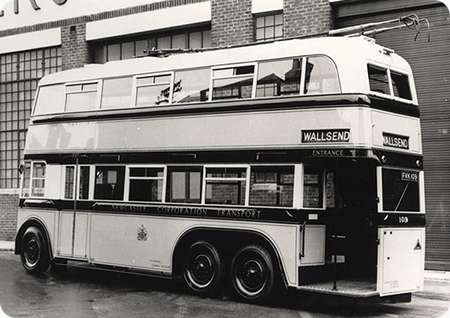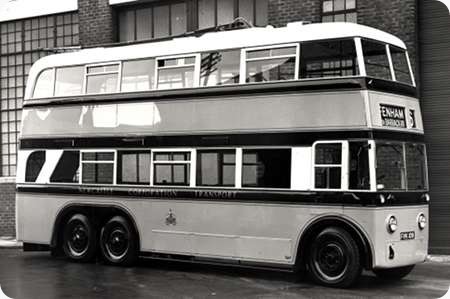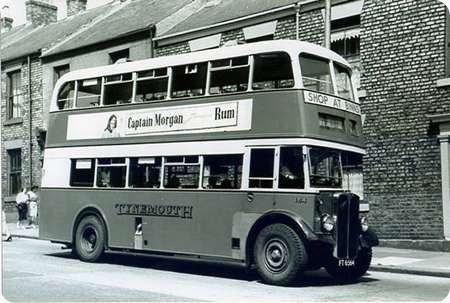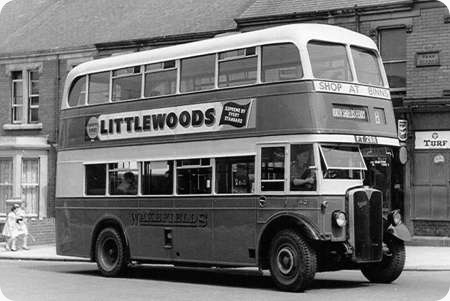Newcastle Corporation – Guy BTX – FVK 109 – 109
Newcastle Corporation
1937
Guy BTX
Northern Coachbuilders H33/27D
Once again, these photos are from the Newcastle City Libraries Archives. They are pre delivery publicity shots of FVK 109, a 1937 Guy BTX, and were taken at the Northern Coachbuilders works which was located on Claremont Road Newcastle, my records suggest that the vehicle may have been a one off. Between 1936 & 38, Newcastle Corporation took delivery of 70 Trolleybuses, this took the fleet numbers from 40 to 109. They were an assorted mixture, 40 to 43 were two axle Karrier E4 with H56R MCCW bodies, the remainder were all three axle types with H33/27D bodies, 17 AEC 664T – 24 Guy BTX and 24 Karrier E6A. 44 to 77 and 85 to 108 were MCCW, 78 to 84 were Roe, that brings us back to 109. However, the next vehicle I have records for is 112, a 1938 Daimler with H33/27D MCCW body, it carried a Coventry registration, DHP 112, and was the only Daimler in Newcastle’s not inconsiderable fleet, which would suggest that it was originally a demonstrator. If they ever existed, I have failed to find any records for fleet numbers 110 and 111, so perhaps 109 was actually one of three. Changing the tack slightly, I don’t understand the thinking behind this style of body, two axle trolleybuses had a capacity of 56, but despite the extra length these were only 60, with most of the extra space taken up by a second set of stairs, and a door at the front, it seems an awful lot of expense for the sake of an extra four seats, post war vehicles had what I suppose would be called a normal configuration with an open platform and one set of stairs, which gave a capacity of 70.
Photograph and Copy contributed by Ronnie Hoye
05/08/14 – 06:57
Handsome and fascinating vehicle. Unusual that the staircase evidently eats up one seat downstairs, Roe fashion, yet—to go by the position of the handrail seen through the back window—also extends some way across the back of the platform in conventional staircase fashion, suggesting that the platform is shorter from front to back—something also suggested by the smallish rearmost side windows upstairs. The front upstairs bay is also unusually long, yet there’s nothing unbalanced about the whole design, at least to my eye. If only one had survived!
Seeing one after another of Ronnie’s posts fills me with envy: what a wonderful variety of characterful vehicles, some run by quite small authorities, bearing bold liveries and stylish lettering, all exuding a real sense of local pride.
Ian T
05/08/14 – 07:06
Newcastle’s pre-war trolleybus fleet was entirely six-wheeled vehicles, ALL with the same basic body design, incorporating two staircases, a front exit with doors and sixty seats. This arrangement was adopted because front exits on trams had been the norm for many years in Newcastle and the trolleybus routes were initially all for tram replacement. The layout was similar to that adopted by Bournemouth Corporation for its trolleys. It may just be coincidence but Newcastle’s livery was also very close to that operator’s, albeit with a much darker shade of yellow as per the cadmium used on the trams.
Bournemouth: //farm3.staticflickr.com/2894/
Newcastle: Here’s a digitally enhanced version of Ronnie’s pic of 109: //farm9.staticflickr.com/8464/
Newcastle’s initial 1935 trolleybus fleet was numbered 10-40, extending by 1940 as the network developed to no. 124. As Ronnie rightly states the numbers 110 and 111 were never used, for reasons unknown. Noel Hanson in his excellent history of Newcastle’s trolleybuses offers two theories. One is that 112, a Daimler demonstrator, was coincidentally registered in Coventry as DHP 112 and so NCT thought it prudent to skip from 109 to 112 to keep registration and panel numbers aligned. OR, the reason was an ‘accounting’ allocation of 110 and 111 by Newcastle to other demonstrators that had been borrowed in 1937/38… Whether they actually asked Daimler for a ‘112’ registration on their demonstrator may never be known!
Incidentally 109 saw the light of day as a chassis-only exhibit at the 1937 motor show, then being purchased by Newcastle who had it bodied during 1938 to its ‘standard’ trolleybus design by local firm Northern Coach Builders. Although about this time NCB were bodying Daimler COG5 double-deckers for the Corporation, 109 remained the only pre-war trolleybus bodied by NCB – quite different from the post-war trolleybus fleet in which NCB bodied 80 out of 186 vehicles.
In the pre-war fleet of 113 pretty well externally identical vehicles, no fewer than four chassis makes (27 AEC 664T, 50 Karrier E6/E6A, 35 Guy BTX and 1 Daimler CTM6) and five bodywork manufacturers (5 English Electric, 5 Brush, 89 MCCW, 13 C H Roe and 1 NCB) were represented. Some kind of record? Looks like Metro-Cammell were very much in favour, again reflecting purchases of motor buses at this time.
Fleet summary:
10-4 AEC 664T (EEC)
15-9 AEC 664T (Brush)
20-9 Karrier E6 (MCCW)
30-9 Guy BTX (MCCW)
40 Karrier E6 (MCCW)
41-2 Karrier E6A (MCCW)
43 Karrier E6 (MCCW)
44-6 Guy BTX (MCCW)
47-56 Karrier E6A (MCCW)
57-66 Guy BTX (MCCW)
67-77 AEC 664T (MCCW)
78 Guy BTX (CH Roe)
79-84 AEC 664T (C H Roe)
85-98 Karrier E6A (MCCW)
99-108 Guy BTX (MCCW)
109 Guy BTX (NCB)
112 Daimler CTM6 (MCCW)
113-8 Karrier E6A (C H Roe)
119-24 Karrier E6A (MCCW)
Tony Fox
Quick links to the - Comments Page - Contact Page - Home Page




